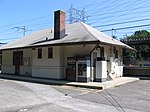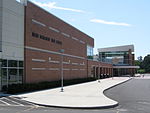Five Mile River Landing Historic District
Historic districts in Fairfield County, ConnecticutHistoric districts on the National Register of Historic Places in ConnecticutNRHP infobox with nocatNational Register of Historic Places in Fairfield County, ConnecticutNorwalk, Connecticut

The Five Mile River Landing Historic District encompasses a predominantly 19th-century residential area in the Rowayton section of Norwalk, Connecticut. It extends along Rowayton Street from Witch Lane to Pennoyer Street, and includes all of the properties on the latter as well. The area was a major local center of the shipping industry in the 19th century. The historic district was listed on the National Register of Historic Places in 2009.
Excerpt from the Wikipedia article Five Mile River Landing Historic District (License: CC BY-SA 3.0, Authors, Images).Five Mile River Landing Historic District
Jo's Barn Way, Norwalk
Geographical coordinates (GPS) Address Nearby Places Show on map
Geographical coordinates (GPS)
| Latitude | Longitude |
|---|---|
| N 41.070269444444 ° | E -73.443005555556 ° |
Address
Jo's Barn Way 4
06853 Norwalk
Connecticut, United States
Open on Google Maps








